Contact us today:
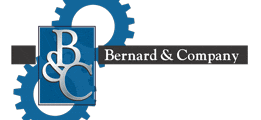
(847) 934-4500
tdaro@bernardandcompany.com

Contact us today:
(847) 934-4500
tdaro@bernardandcompany.com
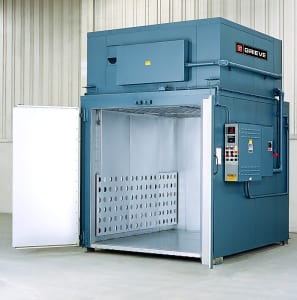
This Grieve walk-in oven features 4” insulated walls, aluminized steel exterior and interior, removable top-mounted heating chamber and a fully insulated floor. The oven is built with all safety equipment required by NFPA Standard 86 for flammable solvents, including a powered forced exhauster, airflow safety switch and purge timer.
Other controls on No. 806 include a fused disconnect switch, digital temperature controller and manual reset excess temperature controller.
For more information, please contact:
THE GRIEVE CORPORATION
500 Hart Road
Round Lake, IL 60073-2898
Phone: (847) 546-8225
Fax: (847) 546-9210
Web: www.grievecorp.com
Email: sales@grievecorp.com
Attention: Frank Calabrese, VP
No. 910 is a 1000ºF, gas-fired, high-temperature walk-in oven from Grieve, currently used for heat cleaning large valve bodies at the customer’s facility. Workspace dimensions of this oven measure 60” W x 120” D x 78” H. 880,000 BTU are installed in a modulating natural gas burner to heat the oven chamber, while a 12,500 CFM, 10 HP recirculating blower provides combination airflow to the workload.
This Grieve oven features 8” thick insulated walls made from 2” of 1900ºF block and 6” of 10 lb/cf density rockwool; top-mounted heat chamber; 16 ga aluminized steel oven interior, 16 ga stainless steel heat chamber interior and 16 ga aluminized steel exterior. Inner and outer door gaskets are provided, with the inner gasket sealing directly against the door plug and the outer gasket sealing directly against the face of the oven. The 6” insulated oven floor features truck wheel guide tracks and Grieve also furnished the customer an 8000 lb capacity flatbed loading truck with this walk-in oven.
All safety equipment required by IRI, FM and NFPA Standard 86 for gas-heated equipment are provided on the oven, including a 1500 CFM, 2 HP powered forced exhauster.
Controls on No. 910 include a digital programming temperature controller.
For more information, please contact:
THE GRIEVE CORPORATION
500 Hart Road
Round Lake, IL 60073-2898
Phone: (847) 546-8225
Fax: (847) 546-9210
Web: www.grievecorp.com
Email: sales@grievecorp.com
Attention: Frank Calabrese, VP
Better welding control helps R.H. Peterson produce a new line of grills achieve up to 30% improvement savings. View the case study here and visit Siemens at Fabtech, Booth S-4686.
For additional product information and inquiries, call (800) 879-8079 ext. Marketing Communications or send an e-mail to: SiemensMTBUMarCom.industry@siemens.com.
Follow us on Facebook: www.facebook.com/SiemensCNC or Twitter: www.twitter.com/siemens_cnc_us.
—
Siemens Industry Sector is the world’s leading supplier of innovative and environmentally friendly products, solutions and services for industrial customers. With end-to-end automation technology and industrial software, solid vertical-market expertise, and technology-based services, the sector enhances its customers’ productivity, efficiency and flexibility. With a global workforce of more than 100,000 employees, the Industry Sector comprises the Industry Automation, Drive Technologies and Customer Services Divisions as well as the Metals Technologies Business Unit. For more information, visit http://www.usa.siemens.com/industry.
The Siemens Drive Technologies Division is the world’s leading supplier of products, systems, applications, solutions and services for the entire drive train, with electrical and mechanical components. Drive Technologies serves all vertical markets in the production and process industries as well as the infrastructure/energy segment. With its products and solutions, the division enables its customers to achieve productivity, energy efficiency and reliability. For more information, visit http://www.usa.siemens.com/drivetechnologies.
Continue readingMultiple machines and services from longtime leader in stamping presses to be displayed at FABTECH Booth 4363
The HEIM Group has been designing and manufacturing presses for over 65 years. The company’s HEIM and ROUSSELLE press brands are known worldwide for their quality construction and performance. Built in the Chicago factory, using American-made components, whenever possible, the presses have a reputation for dependable operation, competitive price and superior support from dealers and inside staff. 
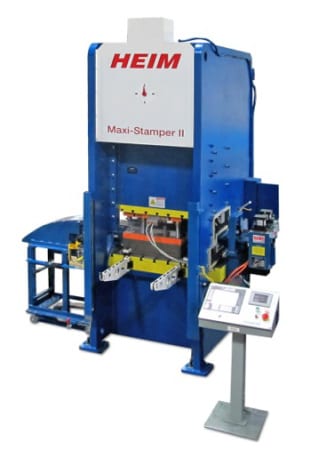
Click to see the presses in action!
For more information, please stop by Booth S4363 at FABTECH or contact:
The Heim Group
6360 W. 73rd. St.
Chicago, IL 60638
Phone: 708.496.7400
Fax: 708.496.7428
Email: info@theheimgroup.com
Website: www.theheimgroup.com
Attention: Gina Petraitis
Visit Siemens at Fabtech 2013, Booth S-4686
UPDATE! See the video of Siemens at FabTech HERE.
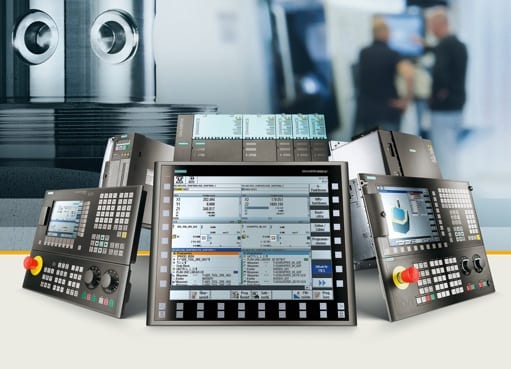
Broad-based CNC competence: Siemens will be demonstrating how productivity, flexibility and safety can be increased in CNC production with an array of smart additions to its Sinumerik portfolio
Industrial corporations are facing deep-rooted changes in the world of manufacturing. These changes are taking place alongside increasing integration of product development and production processes with the benefit of innovative software systems and high-performance software – a decisive step on the road toward a new industrial age in manufacturing. “Siemens has invested a lot of work in the integration of automation technology along the entire value chain over a period of many years, and is playing a cutting-edge role in shaping the future of production,” stated Robert Neuhauser, CEO of the Motion Control Systems Business Unit of the Siemens Drive Technologies Division, at a press conference held in the run-up to the EMO 2013. “In the Sinumerik environment in particular, and consequently in the field of CNC production in general, Siemens has been heavily involved for many years already in the area of simulation and the virtual machine, as well as the integration into factory IT systems. Our aim is to drive this process of integration forward to ensure that the field of machine tool construction is also prepared to embrace the next step in the industrial revolution,” continued Neuhauser.
With its Sinumerik family, Siemens offers an integral portfolio of CNC for everything from simple machine tools through standardized machine concepts to modular premium solutions, complete with “smart machine” solutions for the economical manufacture of high-end workpieces. It is working towards the consistent expansion of this CNC technology expertise. “In the future, production models will demand ever greater productivity, flexibility and efficiency, while at the same time expecting simplified machine operation and production sequences. As it continues to develop the Sinumerik CNC portfolio, Siemens is working to satisfy all these expectations,” said Joachim Zoll, Head of Machine Tool Systems Business Segment within the Motion Control Systems Business Unit. The innovations presented by Siemens at the Fabtech 2013 will consequently focus on smart function improvements, which will make for greater CNC operating convenience, increase precision at the workpiece and allow greater machining safety across every category of machine, from the compact to the high-end solution. A new function to protect against unwanted component collisions will be showcased by Siemens, for example, alongside improvements to its cohesive Sinumerik Operate user interface, including upgraded simulation options.
The Sinumerik CNC portfolio is additionally playing an increasingly important role in preparing the ground for the next step in the evolution of CNC production, also within the framework of the Siemens Integrated Drive System (IDS). With a view to optimizing the addition of value across the entire process chain through consistent integration, IDS is used to integrate all the components of the drive train consistently into the complete production process environment. This also applies to Sinumerik CNC system solutions.
For every Sinumerik application, ideally coordinated system components such as high-powered Sinamics drives and Simotics motors have always been used as the ideal complements. Alongside horizontal integration of the entire drive train, with Sinumerik Integrate for Production, Siemens is also allowing vertical integration within the control architecture of industrial manufacturing automation. As the example of a leading passenger car manufacturer illustrates, this type of vertical and horizontal integration within the production process can speed up the series start for a new vehicle by up to 50 percent.

Siemens is extending its preparations for the next step in manufacturing to offer the machine tool building industry an emerging series of integrated solutions. An integrated workpiece measurement system, with a measurement accuracy of 30 nanometers deployed in the world’s biggest precision optics machine, allows the production of telescopes capable of seeing up to 13 billion light years into space
The integration across the entire product life cycle can in turn be implemented using suitable Product Lifecyle Management (PLM) software solutions from Siemens. This concept is already being implemented by leading metals processing industries such as the automotive, aerospace and medical technology sectors. This entails the increasing execution of product development and production planning onscreen, before a single machine tool has even been installed. If a modular machine is developed on a virtual basis right from the outset so that it can be fully simulated, time savings up to 40 percent can be achieved. In running operation, productivity increases of 10 percent or more are also made possible by continued simulation and optimization. At this year’s Fabtech, Siemens will be showcasing the further development of its PLM software, which encompasses scalable solutions for component production and further improved IT integration from the workpiece model through to the machine tool. Siemens will also be revealing the next stage in productivity for NC programming with the further development of its already popular PLM software, NX CAM. Going forward, this software will include special industry-specific machining functions as well as access to a new Manufacturing Resource Library.
For more information on Siemens SINUMERIK CNC, visit www.usa.siemens.com/cnc.
For specific product information and inquiries, call (800) 879-8079 ext. Marketing Communications or send an e-mail to: SiemensMTBUMarCom.industry@siemens.com.
Follow us on Facebook: www.facebook.com/SiemensCNC or Twitter: www.twitter.com/siemens_cnc_us.
—
Siemens Industry Sector is the world’s leading supplier of innovative and environmentally friendly products, solutions and services for industrial customers. With end-to-end automation technology and industrial software, solid vertical-market expertise, and technology-based services, the sector enhances its customers’ productivity, efficiency and flexibility. With a global workforce of more than 100,000 employees, the Industry Sector comprises the Industry Automation, Drive Technologies and Customer Services Divisions as well as the Metals Technologies Business Unit. For more information, visit http://www.usa.siemens.com/industry.
The Siemens Drive Technologies Division is the world’s leading supplier of products, systems, applications, solutions and services for the entire drive train, with electrical and mechanical components. Drive Technologies serves all vertical markets in the production and process industries as well as the infrastructure/energy segment. With its products and solutions, the division enables its customers to achieve productivity, energy efficiency and reliability. For more information, visit http://www.usa.siemens.com/drivetechnologies.
Continue readingCauses, effects and control
This whitepaper covers definitions, harmonic generation, effects of harmonics and control of harmonics. It also addresses general awareness of power system harmonics, their causes, effects and methods to control them especially when these harmonics are related to variable frequency (or adjustable speed) drives.
—
For more information, please visit www.usa.siemens.com/motioncontrol
For specific product information and inquiries, call (800) 879-8079 ext. Marketing Communications or send an e-mail to: SiemensMTBUMarCom.industry@siemens.com.
—
Siemens Industry Sector is the world’s leading supplier of innovative and environmentally friendly products, solutions and services for industrial customers. With end-to-end automation technology and industrial software, solid vertical-market expertise, and technology-based services, the sector enhances its customers’ productivity, efficiency and flexibility. With a global workforce of more than 100,000 employees, the Industry Sector comprises the Industry Automation, Drive Technologies and Customer Services Divisions as well as the Metals Technologies Business Unit. For more information, visit http://www.usa.siemens.com/industry.
The Siemens Drive Technologies Division is the world’s leading supplier of products, systems, applications, solutions and services for the entire drive train, with electrical and mechanical components. Drive Technologies serves all vertical markets in the production and process industries as well as the infrastructure/energy segment. With its products and solutions, the division enables its customers to achieve productivity, energy efficiency and reliability. For more information, visit http://www.usa.siemens.com/drivetechnologies.
Continue readingNew CU250S-2 control unit now in stock; supplements existing Siemens G120 drive with universal vector control and encoder feedback
Siemens Industry, Inc. announced today the availability of the new Sinamics CU250S-2 control unit for use with its popular Sinamics G120 variable speed drives. The unit provides vector control with encoder feedback. Additionally, the operation of single-axis applications with exact speed and torque control on induction motors, as well as positioning tasks with high demand on I/O, are supported, with different encoder interfaces provided on the module. These new units complete the G120 product portfolio and replace the CU240S with encoder interface.
Typical applications for these new control units include single drives with a large number of I/O or those with high speed control requirements, including extruders, centrifuges, wire-drawing machines, basic fabric webs, conveyors, lifters and others in markets ranging from automotive assembly, textiles, printing and chemical processing to nearly all conveyors and material handling.
The new Sinamics CU250S-2 control units can be combined with existing power modules to support all G120 drive applications, with or without encoder evaluation, for demanding applications requiring speed feedback. Additionally, STO (Safe Torque Off), SBC (Safe Brake Control) and SS1 (Safe Stop 1) features are all integrated, enabling their application on basic safety requirements. With the purchase of an optional software license, extended safety functions can be obtained, along with software for a single positioning function (EPos).
Comprehensive communications interfaces for general machine building are provided on this new Sinamics control from Siemens, including Profibus DP, Profinet (Ethernet I/P), RS485 (USS protocol, Modbus RTU) and CANopen, allowing convenient connection to other Siemens systems as well as external automation systems. No external gateway is needed.
Other features include an integrated USB port, so users can simply go online to facilitate engineering set-up and maintenance, plus an integrated slot for an SD card to allow simple cloning and firmware updates or upgrades.
For more information about this line of Sinamics control units, please visit: www.usa.siemens.com/sinamics
For specific product information and inquiries, call (800) 879-8079 ext. Marketing Communications or send an e-mail to: SiemensMTBUMarCom.industry@siemens.com.
Continue readingNorth Carolina shop now utilizing additive manufacturing to assist in the Engineer & Build of Hydraulic Workholding and CNC Production Parts
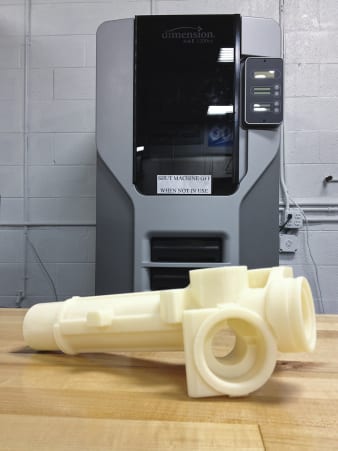
3D printing, also known as additive manufacturing, has been incorporated into the engineer and build phases of workholding devices and other products at James Tool.
Morganton, NC – James Tool designs and manufactures a wide variety of hydraulic workholding devices, used in aerospace, automotive and other high-precision industries. Because of the continuous custom work done here, it is imperative that the company keep abreast of all technological developments in the design and production of its products. To that end, James Tool has recently installed 3D printing, a form of additive manufacturing, to its Engineer & Build Hydraulic Workholding Division at the company. James Tool also offers CNC Production Machining and Non-Production Precision Machining to its customers, who comprise major OEMs and suppliers to aerospace, automotive, off-highway, energy, nuclear and transportation industries.
According to Jeff Toner, president of James Tool, “We are always watching trends in the manufacturing industry and we started seeing 3D printing make an impact, some years ago. We waited until the technology had evolved and become more affordable before making our investment.” The first machine was purchased recently and is currently used to support the company’s workholding division as well as help in the estimating of CNC machining opportunities.
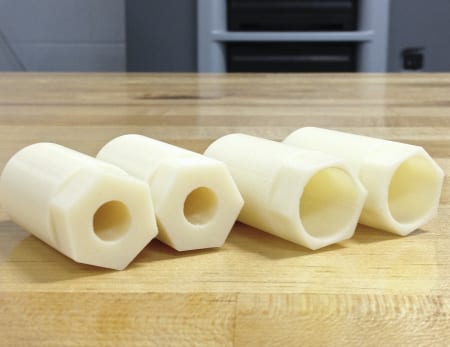
The process involves the incremental build-up of metal material to produce a working model, used for production evaluation, sales presentations and possible design modifications.
3D printing is a form of additive manufacturing, in which material is built-up, one layer at a time, to create a 3D solid working model from a CAD file. James Tool engineers believe this technology is substantially changing the way the company can serve its customers. It is referenced as additive manufacturing to distinguish it from the subtractive process of traditional machining, in which metal chips are removed from the surface of a blank workpiece.
James Tool assigned a team to research the current 3D printing technology in great detail, before making their purchase decision to acquire a Stratasys Dimension 1200ES machine. This machine has the capability of running parts with a 10” x 10” x 12” envelope in an ABS plastic substrate.
As Toner explains, “We were up and running parts within two hours, after the installation and set-up. This included the initial calibration on the machine and training from the local technician. The 3D printing image gives our engineers a cleaner concept and enables a much more robust design process, as we can see clamping tabs, locating pins and the entire work envelope more clearly. This results in an easy-to-use, cost effective tool, plus we have significantly shorter times needed for quote and order-to-first part sequencing.” Because James Tool had run 3D imaging in its CAD designs for over 15 years, the transition to 3D printing was practically seamless, he added.
James Tool Vice President and General Manager Tim King further notes that, while the interaction between James Tool and its customers has not changed substantially, it is quite helpful to have an actual part generated through the 3D printing process, before engineering and quoting begin. He sees this new capability as a positive extension of the existing customer service process at his company. The first customer orders to benefit from the use this system at James Tool have already been secured and the results have exceeded expectations, King said. “When you can go into a meeting with an actual part in hand, it can help in many ways. The customer and we can often see desirable changes that might make the component function more effectively, be easier to machine, or both.”
Peering into the crystal ball for a moment, Jeff Toner also notes that he sees additive manufacturing as a true “game changer” for the machining world. “The day is not far off when subtractive machining will be obsolete and actual production parts will be printed rather than machined using conventional methods, on a very large number of the jobs we handle.” He plans that his company will soon become a regional leader in the additive and other advanced technology arenas. “The future of 3D manufacturing is really limitless, as anybody can now order a desktop 3D printer for their business or home office and have a 3D prototype part in less than a few hours, once they master the system. I expect this technology will revolutionize manufacturing and create a new breed of entrepreneurs in our industry and others.”
Quantifying the impact of this new technology at James Tool, Jeff Toner concludes that 3D printing has already reduced engineering and quoting time substantially for workholding fixtures and CNC production jobs at his company. James Tool runs roughly an equivalent amount of work in production and one-off or short run jobs.
In its ongoing effort to maintain a quality workforce, the company partners with Kennametal on tooling advancements, as well as maintaining a full training facility on its Morganton, North Carolina campus, which has recently expanded to house more machining, finishing, quality lab and large work piece handling equipment. James Tool actively trains many of its employees in cross-functional machining operations, proven out by the many work cells the company operates in its various shop departments. Jeff Toner and Tim King both believe this strategy makes the company more flexible and capable for its customers.
For more information on this story, please contact:
James Tool Machine & Engineering, Inc.
130 Reep Drive
Morganton, NC 28655
Phone: 828-584-8722
Fax: 828-584-8779
Web: www.jamestool.com
Email: sales@jamestool.com
Attention: Kevin Moses or Jeff Toner
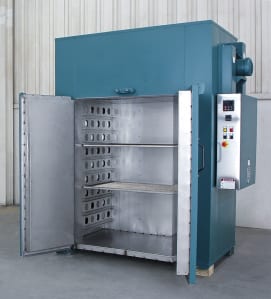
This Grieve cabinet oven features 6” thick insulated walls, top-mounted heat chamber, plus an aluminized steel interior and exterior.
Controls onboard No. 1025 include a digital indicating temperature controller, SCR power controller, manual reset excess temperature controller with separate contactors and a recirculating blower airflow safety switch.
For more information, please contact:
THE GRIEVE CORPORATION
500 Hart Road
Round Lake, IL 60073-2835
Phone: (847) 546-8225
Fax: (847) 546-9210
Web: www.grievecorp.com
Email: sales@grievecorp.com
Attention: Frank Calabrese
Major machine tool company in Detroit supporting


Speaking at Oakland Community College on September 3, Senator Stabenow said her new bill would provide a federal match equal to state training reimbursements, so that the repayment to the colleges would occur more quickly, plus there would be an increase in the number of eligible companies and workers participating.

Senator Stabenow further remarked, “This program is a partnership between businesses and the community colleges, reaching out to workers. And it’s a way for the federal government to recognize that new job skills training – to match the jobs now available – is a top priority for moving the economy forward.”
The New Jobs Training Program in Michigan was begun in 2008 and last year trained nearly 10,000 workers in partnership with 44 companies, generating $76 million in additional wages for the Michigan labor force.
For more information on this announcement, please contact:
Kristal Kilgore
EMAG LLC
38800 Grand River Avenue
Farmington Hills, MI 48335
Tel: (248) 875-0313
Fax: (248) 477-7784
E-mail: kkilgore@emag.com
Web: www.emag.com